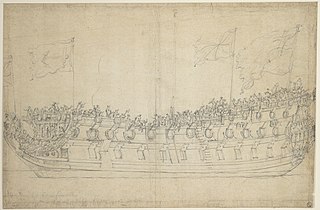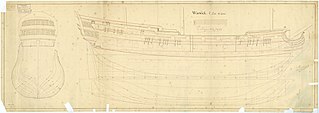
Ship models or model ships are scale models of ships. They can range in size from 1/6000 scale wargaming miniatures to large vessels capable of holding people.

Sir Robert Seppings, FRS was an English naval architect. His experiments with diagonal trusses in the construction of ships led to his appointment as Surveyor of the Navy in 1813, a position he held until 1835.

HMS Stirling Castle was a 70-gun third-rate built at Deptford Dockyard, in 1678/79. She was in active commission for the War of the English Succession, fighting in the Battles of Beachy Head and Barfleur. HMS Stirling Castle underwent a rebuild at Chatham Dockyard in 1699. She was in the Cadiz operation in 1702. The ship was wrecked on the Goodwin Sands off Deal on 27 November 1703. The remains are now a Protected Wreck managed by Historic England.

The Vengeur-class ships of the line were a class of forty 74-gun third rates, designed for the Royal Navy as a joint effort between the two Surveyors of the Navy at the time. The Vengeur Class, sometimes referred to as the Surveyors' class of third rates, amongst other names, was the most numerous class of ships of the line ever built for the Royal Navy - forty ships being completed to this design. Due to some dubious practices, primarily in the commercial dockyards used for construction, this class of ships earned itself the nickname of 'Forty Thieves.'

D'Hautpoul was a Téméraire class 74-gun French Navy ship of the line launched at Lorient on 2 September 1807. She was previously named Alcide and Courageux.

The Cruizer class was an 18-gun class of brig-sloops of the Royal Navy. Brig-sloops were the same as ship-sloops except for their rigging. A ship-sloop was rigged with three masts whereas a brig-sloop was rigged as a brig with only a fore mast and a main mast.
HMS Newcastle was a 50-gun fourth rate ship of the line of the Royal Navy, built by Joseph Allin the elder at Sheerness Dockyard and launched on 10 March 1704.

HMS Cumberland was a three-deck 80-gun third rate ship of the line of the Royal Navy, built by Joseph Allin the elder at Deptford Dockyard and launched on 27 December 1710. Her design corresponded to that laid down by the 1706 Establishment of dimensions for 80-gun ships.

HMS Lion or Lyon was a 60-gun fourth rate ship of the line of the Royal Navy, built at Chatham Dockyard to the 1706 Establishment and launched on 20 January 1709.

HMS Warwick was a 60-gun fourth-rate ship of the line of the Royal Navy, built to the 1719 Establishment at Plymouth by Peirson Lock. The keel was laid down on 1 April 1730, and the ship was launched on 25 October 1733, and completed on 24 August 1734.

HMS Vengeance was originally the 48-gun French Navy frigate Vengeance and lead ship of her class. She engaged USS Constellation during the Quasi-War, in an inconclusive engagement that left both ships heavily damaged. During the French Revolutionary Wars, HMS Seine hunted Vengeance down and captured her after a sharp action. She was recommissioned in the Royal Navy as the 38-gun fifth rate HMS Vengeance, but the British apparently never returned her to seagoing service. Accounts are divided as to her eventual fate. She may have been broken up in 1803 after grounding in 1801, or continued as a prison ship until 1814.

The Cormorant class were built as a class of 16-gun ship sloops for the Royal Navy, although they were re-rated as 18-gun ships soon after completion.

HMS Brilliant was a 36-gun Venus-class fifth-rate frigate of the British Royal Navy that saw active service during the Seven Years' War with France. She performed well against the French Navy in the 1760 Battle of Bishops Court and the 1761 Battle of Cape Finisterre, but was less capable when deployed for bombardment duty off enemy ports. She also captured eight French privateers and sank two more during her six years at sea. The Royal Navy decommissioned Brilliant in 1763. The Navy sold her in 1776 and she became an East Indiaman for the British East India Company (EIC). Brilliant was wrecked in August 1782 on the Comoro Islands while transporting troops to India.

HMS Wild Swan was an Osprey-class sloop built for the Royal Navy in the mid-1870s. She was launched in 1877 and became a base ship in 1904, being renamed Clyde. She was renamed Columbine in 1913 and was sold for breaking in 1920.

Joseph Tucker was joint Surveyor of the Navy alongside Robert Seppings from 1813 until his retirement in 1831.

HMS Aigle was a 36-gun, fifth-rate frigate of the Royal Navy. Ordered on 15 September 1799 and built at Bucklers Hard shipyard, she was launched 23 September 1801. More than fifty of her crew were involved in the Easton Massacre when she visited Portland in April 1803 to press recruits. Her captain and three other officers stood trial for murder but were acquitted. Much of Aigle's career as a frigate was spent trying to keep the English Channel free of enemy warships and merchant vessels. On 22 March 1808, she was first into the action against two large French frigates, compelling one to seek the shelter of the Île de Groix batteries and forcing the other onto the shore.

Royal Adelaide was a royal yacht, designed as a miniature sailing frigate, which was built in 1833 and launched in the following year on the orders of King William IV of the United Kingdom, for use on Virginia Water Lake in Windsor Great Park in Surrey, England.
John Yelland (1755–1827) was an officer in the Royal Navy who served during the American Revolutionary, French Revolutionary and Napoleonic wars. He commanded HMS Monarch at Copenhagen in 1801, for which he was mentioned in despatches but despite this and having served under some influential admirals, his promotion was slow and he never rose above the rank of captain.
The 1677 Construction Programme was a group of Royal Navy ships of the line approved on 5 March 1677. This program authorised the construction of thirty new warships for the Royal Navy and was a compromise between the 40 ship programme proposed by Samuel Pepys in 1675 and the Parliamentary counter proposal of twenty ships in 1676. This programme included the construction of one first rate, nine second rates, and twenty third rate naval vessels.

The Narcissus-class frigate was a 32-gun, 18-pounder fifth-rate frigate class of five ships of the Royal Navy. Designed by Surveyor of the Navy Sir John Henslow, the class was created to make use of shipyards that could not construct larger frigates. They were similar in design to the preceding 32-gun frigate class, the Amphion class, but were slightly shorter. Two ships were initially constructed, with a later batch of three being ordered in response to an Admiralty request for the resumption of production of proven frigate designs. The final two ships of the class were cancelled when the shipyard they were being constructed at went bankrupt. Unlike her sister ships, the name ship of the class Narcissus was armed with experimental short 24 pounders rather than 18 pounders.
















